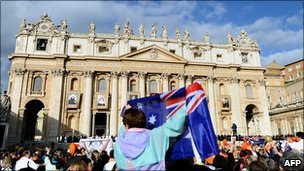Among those attending the Mass were hundreds of nuns from the order MacKillop helped found, the Sisters of St Joseph of the Sacred Heart.
“We’ve always believed that Mary was a saint,” said 65-year-old Moya Campbell, a member of the order. Father Thomas Casanova, a priest from New South Wales and a distant relative of MacKillop, said it was a momentous occasion. “I’ve been looking forward to this since I was a child,” he said. Others wanted to recognise MacKillop’s lifetime of commitment to poor people, including Australia’s Aboriginal population. “She supported Aboriginal people because she believed in supporting people who were disadvantaged,” said pilgrim Melissa Brickell. For anyone to become a saint, the Church has to recognise their intermediary role in two miracles.
In MacKillop’s case, both were in relation to people who were ruled to have been cured of cancer after praying for the nun’s assistance.
Veronica Hopson was the first person MacKillop is said to have healed – she recovered from leukaemia in 1961.
Mary MacKillop was excommunicated in 1871, but the Church later exonerated her. She was eventually put on the road to sainthood by Pope John Paul II, who beatified her in 1995.
Australian Foreign Minister Kevin Rudd, who attended the Mass, has described MacKillop as “an extraordinary Australian woman”. Because of her role in exposing clerical abuse, some have called for MacKillop to made a patron saint of abused children.





